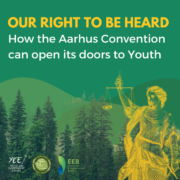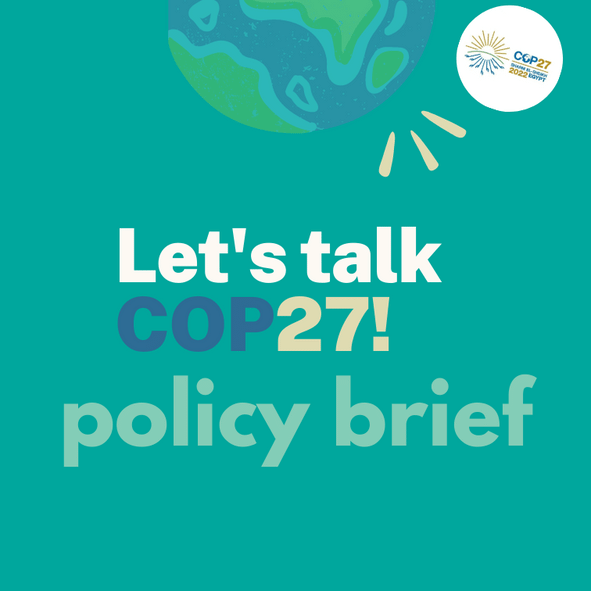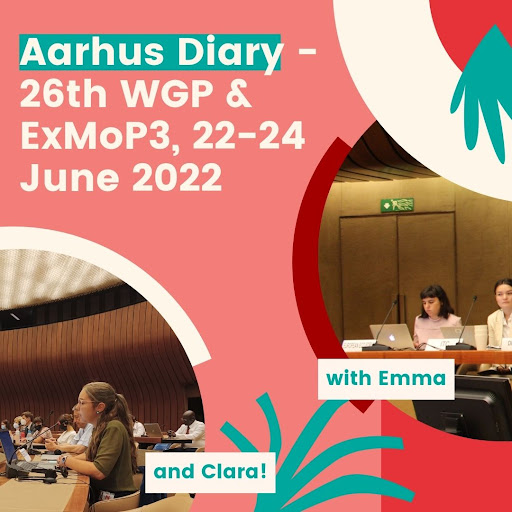
Written by
Margarida Martins (EEB), Ruby Silk (EEB) and Emma Pagliarusco (YEE)
Contents
Visual summary










Share this article
What is the Aarhus Convention and why is it important for young people and future generations?
Climate change poses real threats to the future of the youngest generations through both extreme and gradually escalating weather events, with manyfold repercussions. This looming threat has even proven to lead to “climate anxiety”, a serious and negative psychological phenomenon affecting the current generation of young people in particular and associated with the “perceived failure by governments to respond to the climate crisis”.
The latest IPCC report echoes these disproportionate threats to the youngest generations and sheds light on the intergenerational dimension of the climate change problem: in order to respect, protect and fulfil the rights of today’s youth and future generations, there is an urgent need for environmental laws which are more ambitious than ever before and implemented in the fastest possible way.
The Aarhus Convention and young people
Since its adoption in 1998, the Aarhus Convention has been hailed as the leading international agreement on environmental democracy. It has brought three key environmental rights to our doorsteps: the right to information, public participation in decision-making and access to justice in environmental matters.
The idea underpinning the Convention is no other than participatory democracy: to empower citizens and civil society to participate in environmental matters. For this reason, national authorities of State Parties are legally bound to make Aarhus rights effective. This means that they have to ensure the implementation as well as enforcement of the Aarhus provisions within public processes. Since its enactment, numerous Communications have been brought by NGOs as well as individuals to the Aarhus Convention Compliance Committee to challenge state practices, with energy and spatial planning being the most common sectors addressed.
Article 3(8) of the Convention also states that Parties shall ensure that persons who exercise their Aarhus rights are not penalised for their involvement. This is critically important since environmental defenders are constantly and increasingly under attack across the globe, facing intimidation, harassment, stigmatisation and criminalisation, assaults and even murder. Among them are a high number of young people and children. Global Witness has recorded that 1,539 environmental defenders were killed between 2012 and 2020 worldwide, and the real figure is likely much higher, given that many murders go unreported.
Unfortunately, young climate activists systemically face many different challenges when seeking to exercise their rights protected by the Aarhus Convention. The targeting of youth activists is taking place in multiple and different ways across Aarhus State Parties: through brutal repression of climate movements; enacting new laws to limit and criminalise strikes (with the latest example of Italy); and through intimidation against environmental defenders (e.g., through SLAPP strategies; and even violence such as in France). There are increasingly more barriers to youth public participation, access to information and access to justice. In this regard, States constantly fall short of their obligation to guarantee the right of public participation of young people in environmental decision-making. Youth underrepresentation and generational imbalances are incompatible with democratic participation. Besides, the costly nature of going to court – which we call climate litigation – very clearly impairs the right of young people to access justice.
The Aarhus Convention is a vital piece of legislation that can ensure that the principle of intergenerational equity is included in environmental action. Article 1 recognises the role of the Convention’s pillars in contributing to the protection of the rights of every person of present and future generations. The recognition of the rights of future generations in a legal text – and an international treaty at that – is very rare and should be highlighted. It has the potential to bridge the gap left by the lack of youth representation in decision-making at the national level, ensure a level playing field in the protection of youth activists and serve as good practice for other international environmental legal frameworks.
Youth participation in Aarhus processes
Why should the Convention promote and incorporate young voices?
There are many reasons why young people and youth organisations need to have adequate capacity to exercise their Aarhus Convention rights. Young people have a bigger stake in future problems, as they have lived in an epoch which is also defined by environmental crises.
Youth-led movements and actions have taken an active stance on promoting sustainability and protecting the environment, which is unfortunately not reflected in the current environmental legal framework, apart from references in non-binding international documents such as Agenda 21, a plan of action adopted at the 1992 Rio Earth Summit, which is far from enough.
Despite its capacity and uniqueness, even the Aarhus Convention is far from being considered a well-functioning instrument for the promotion and protection of procedural rights of the youngest: just speaking about its processes, throughout YEE’s experience in two task forces, one MoP and one WGP, we noticed a substantive gap left by the lack of youth participation. This representational imbalance presents several hurdles to the effectiveness and legitimacy of the legislative process.
First of all, youth participation is key to the legitimisation of environmental decisions amongst the young public. Considering the disproportionate climate change impacts that the youngest generations will suffer from, and considering that youth represents 30% of the population in the world, excluding youth from environmental law is one step towards climate injustice and systemic suppression of youth voices.
Secondly, the urgency felt by youth with regard to the climate emergency is unique in its kind and, when taken into consideration adequately, leads to the adoption of more ambitious and binding environmental laws.
Thirdly, including youth voices in the Aarhus Convention processes is also in line with adopting a rights-based approach to environmental legislation, therefore contributing to a more holistic consideration of the various impacts of climate change. Considering that climate change is also a human rights crisis, youth voices in the Aarhus Convention processes are needed in order to take into consideration the disproportionate impacts of climate change on all groups, including the marginalised and potentially vulnerable ones.
Last but not least, in line with Article 1 of the Aarhus Convention the principle of intergenerational equity should be given effective meaning and implemented at a national level as well as at the Convention level. This is impossible without including young people in decision-making processes.
Opportunities for youth involvement
How youth can be better involved in processes (what the Secretariat can do)
In light of the previous section, the Secretariat of the Aarhus Convention is uniquely positioned to promote intergenerational dialogue and enhance the exercise of procedural rights amongst youth. Here are a few steps it can take to promote intergenerational equity:
- Youth should be involved in a systematic way in the Aarhus processes, for example through the establishment of a permanent youth advisory board, (such as UN Youth Advisors, UN Human Rights Youth Advisory Board). Regarding its feasibility, the Secretariat could disseminate the opportunities for youth participation to national youth focal points and NGOs to ensure that the call is open and transparent and that different youth-led groups are represented in all their diversity. The appointment of such youth envoys could follow an election process, or be the result of a competitive application process;
- Youth movements and representatives need to be actively supported in the exercise of access to justice. Cost abatement of climate litigation and access to the courts is essential in order to ensure access to justice for everyone (including young people) without any discriminatory obstacles. Promoting access to justice in environmental matters amongst youth also means promoting and offering pro bono legal counselling, as linguistically and culturally appropriate, to climate activists engaging or willing to engage in climate litigation, with a special focus on marginalised and potentially vulnerable groups.
How to include youth in Aarhus rights at the national level
The Aarhus Convention is also a good forum to mainstream youth participation in environmental decision-making at the national level. Through Aarhus-related processes intergenerational and multi-stakeholder dialogue can take place, good practices can be shared and the principle of intergenerational equity can be promoted. In order to include youth in Aarhus rights at the national level, State Parties should take the following steps:
- Parties should include youth representatives in the Convention processes with a vision to foster meaningful youth engagement and ensure fair democratic representation in line with the principle of intergenerational equity.
- States should adopt the necessary legislation that reflects their environmental goals, taking into account any international obligations. In this process, it is vital that there is access to justice provisions, which ensure that the public concerned can scrutinise authorities’ decisions which have an impact on the environment (per Article 9(3) of the AC). The process should also be made accessible to youth.
- States should ensure that environmental information is made accessible to the youngest members of the public, including children.
- States are urged to decriminalise youth activism and start a process to involve youth activists in decision-making processes as an alternative channel.
- Connected with this last point, it is fundamental that States support more systematically the mandate of the Special Rapporteur on Environmental Defenders and collaborate with youth and non-youth NGOs active on the matter.
The Rapid Response Mechanism, a mechanism under the Aarhus Convention that provides emergency response to environmental defenders in situations of danger, also addresses the many challenges youth climate activists face, including criminalisation and repression following climate action. Young climate activists need protection. In this regard, appointing youth national focal points or hubs in coordination with the RRM would be beneficial as it would allow young people to easily approach them when seeking the enforcement of Aarhus provisions. The mandate of the Special Rapporteur should take into account social and cultural differences and collaborate with national governments to abate any linguistic, cultural, social and political barriers to the enjoyment of Aarhus rights. Likewise, it will be necessary to devote provisions to young people, with special attention to the possibility for underage people to benefit from the RRM.
Stronger Environmental Rights on the Horizon for the Youth
In conclusion, all people of the present generation should be able to meaningfully and effectively exercise their rights under the Aarhus Convention and shape the environmental and climate policies that affect their lives and the lives of future generations. All Parties to the Convention – as well as the Convention itself – have a duty to ensure this is done properly, and swiftly. The latest developments discussed above indicate that there are stronger environmental rights on the horizon for the youth to acquire.
YEE additional resources
More To Explore
Our mission
 YEE aims to unite environmental youth non-profit organisations in Europe in order to enhance international cooperation, increase knowledge about the climate crisis, raise awareness of environmental problems and to strengthen participation of youth in environmental decision-making.
YEE aims to unite environmental youth non-profit organisations in Europe in order to enhance international cooperation, increase knowledge about the climate crisis, raise awareness of environmental problems and to strengthen participation of youth in environmental decision-making.
Get in touch
Vinohradská 2165/48
120 00 Praha 2 – Vinohrady
Czech Republic
E-mail: yee@yeenet.eu


Financially supported by the European Youth Foundation of the Council of Europe. The views expressed do not necessarily reflect the official position of the Council of Europe









